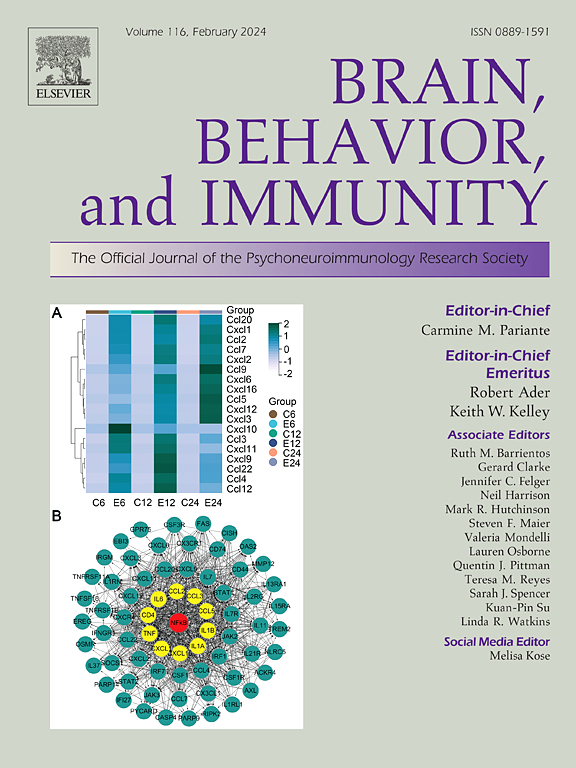Prolonged STAT1 signaling in neurons causes hyperactive behavior
IF 8.8
2区 医学
Q1 IMMUNOLOGY
引用次数: 0
Abstract
The interferon (IFN)-induced STAT1 signaling pathway is a canonical immune pathway that has also been implicated in regulating neuronal activity. The pathway is enriched in brains of individuals with autism spectrum disorder (ASD) and schizophrenia (SZ). Over-activation of the STAT1 pathway causes pathological transcriptional responses, however it is unclear how these responses might translate into behavioral phenotypes. We hypothesized that prolonged STAT1 signaling in neurons would be sufficient to cause behavioral deficits associated with neurodevelopmental disorders. In this study, we developed a novel mouse model with the clinical STAT1 gain-of-function mutation, T385M, in neurons. These mice were hyperactive and displayed neural hypoactivity with less neuron counts in the caudate putamen. Driving the STAT1 gain-of-function mutation exclusively in dopaminergic neurons, which project to the caudate putamen of the dorsal striatum, mimicked some hyperactive behaviors without a reduction of neurons. Moreover, we demonstrated that this phenotype is neuron specific, as mice with prolonged STAT1 signaling in all excitatory or inhibitory neurons or in microglia were not hyperactive. Overall, these findings suggest that STAT1 signaling in neurons is a crucial player in regulating striatal neuron activity and aspects of motor behavior.
神经元中长期的 STAT1 信号传递会导致过度活跃的行为。
干扰素(IFN)诱导的 STAT1 信号通路是一种典型的免疫通路,也与调节神经元活动有关。自闭症谱系障碍(ASD)和精神分裂症(SZ)患者的大脑中富含该通路。STAT1 通路的过度激活会导致病理转录反应,但目前还不清楚这些反应如何转化为行为表型。我们假设,神经元中长期的 STAT1 信号转导足以导致与神经发育障碍相关的行为缺陷。在这项研究中,我们开发了一种新型小鼠模型,它的神经元中存在临床 STAT1 功能增益突变 T385M。这些小鼠过度活跃,并表现出神经活性低下,尾状核视丘神经元数量较少。STAT1 功能增益突变只作用于多巴胺能神经元(这些神经元投射到背侧纹状体的尾状核),能模拟出一些多动行为,但神经元数量并没有减少。此外,我们还证明了这种表型具有神经元特异性,因为在所有兴奋性或抑制性神经元或小胶质细胞中STAT1信号传导时间延长的小鼠并没有亢奋行为。总之,这些研究结果表明,神经元中的 STAT1 信号是调节纹状体神经元活动和运动行为的关键因素。
本文章由计算机程序翻译,如有差异,请以英文原文为准。
求助全文
约1分钟内获得全文
求助全文
来源期刊
CiteScore
29.60
自引率
2.00%
发文量
290
审稿时长
28 days
期刊介绍:
Established in 1987, Brain, Behavior, and Immunity proudly serves as the official journal of the Psychoneuroimmunology Research Society (PNIRS). This pioneering journal is dedicated to publishing peer-reviewed basic, experimental, and clinical studies that explore the intricate interactions among behavioral, neural, endocrine, and immune systems in both humans and animals.
As an international and interdisciplinary platform, Brain, Behavior, and Immunity focuses on original research spanning neuroscience, immunology, integrative physiology, behavioral biology, psychiatry, psychology, and clinical medicine. The journal is inclusive of research conducted at various levels, including molecular, cellular, social, and whole organism perspectives. With a commitment to efficiency, the journal facilitates online submission and review, ensuring timely publication of experimental results. Manuscripts typically undergo peer review and are returned to authors within 30 days of submission. It's worth noting that Brain, Behavior, and Immunity, published eight times a year, does not impose submission fees or page charges, fostering an open and accessible platform for scientific discourse.

 求助内容:
求助内容: 应助结果提醒方式:
应助结果提醒方式:


